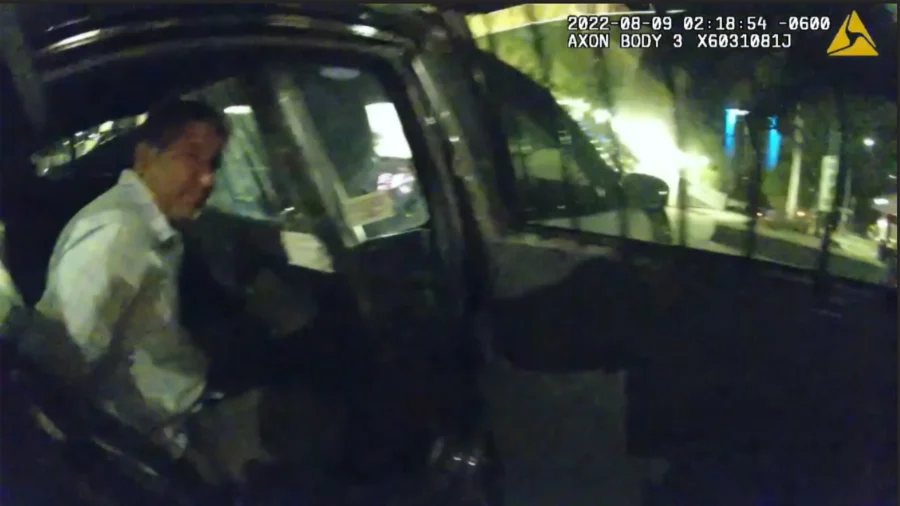ALBUQUERQUE, N.M.—Prosecutors on Friday wrapped up their case against an Afghan refugee on charges that he gunned down a man in 2022 in what turned out to be the first of three ambush-style killings involving members of the Muslim community in New Mexico’s largest city.
Muhammad Syed, who settled in the U.S. several years ago with his family, quickly became the main suspect after authorities issued photographs of a vehicle believed to be involved in the shootings. He was taken into custody after being pulled over in the vehicle more than 100 miles (160 kilometers) from Albuquerque.
He told authorities at the time he was concerned about the killings and was on his way to Texas to find a new home for his family. He denied involvement in the killings.
Syed, who speaks Pashto and required the help of translators throughout the trial, has remained in custody without bond since his arrest in August 2022. He is charged with three counts of murder and four charges of tampering with evidence.
Syed, 53, faces separate trials for each victim, the first being 41-year-old Aftab Hussein. The other trials will happen in the coming months.
When asked by the judge Friday whether he wished to testify, Syed stood up and adjusted his headphones as a translator relayed the question. He choked back tears and began to cry. He eventually said in Pashto that he would reserve his right to remain silent.
The defense called no witnesses, and prosecutors did not address a motive or discuss any interactions that Syed might have had with Hussein.
Jurors were scheduled to begin their deliberations Monday morning.
Prosecutors detailed the night of the shooting: It was around 10 p.m. when Hussein pulled up to his apartment complex and parked. He had just stepped out of his vehicle with keys still in hand when gunfire erupted.
“He stood no chance,” prosecutor Jordan Machin said during closing arguments, alleging that Syed was lying in wait and that he continued to shoot as Hussein was on the ground.
Officers found Hussein with multiple wounds that stretched from his neck down to his feet. Investigators testified that some of the high-caliber rounds went through his body and pierced the car.
While questioning a firearms and ballistic expert with the police department, Deputy District Attorney David Waymire pulled out a rifle that had been seized during a search of Syed’s home. It had been found under the defendant’s bed. Waymire also showed jurors bags of spent casings and bullet fragments collected from the scene.
In a yellow envelop was a bullet that had been retrieved by medical examiners from Hussein’s body.
The expert said testing determined the casings and projectiles were fired from Syed’s rifle.
Cellphone records also indicated that Syed was at the scene about 20 minutes before the shooting and that it appeared he left right after and headed home, prosecutors said. They also introduced as evidence a note in Syed’s phone that referred to testing the rifle on the date that Hussein was killed.
Previous court filings described Syed as having a violent history, none of which was mentioned in court. His public defenders have argued that previous allegations of domestic violence never resulted in convictions.
Defense attorneys attempted to introduce doubt throughout the trial, saying prosecutors had no evidence that Syed was the one who pulled the trigger. They suggested other people who lived in Syed’s home also had access to his phone, his vehicle and the rifle.
They also argued there were no fingerprints or DNA collected during the investigation that would implicate Syed.
Megan Mitsunaga, one of Syed’s attorneys, told jurors during closing arguments that her client was innocent and that investigators can sometimes get “tunnel vision” once they seize on a suspect and stop looking at evidence that doesn’t support that person’s guilt. She suggested there were gaps that should leave jurors with reasonable doubt.
“How is that fair to Mr. Syed, how is that fair to this community to have law enforcement pick and chose which evidence they want you to hear about?” she said.
Machin said it was Syed who tried to flee to Texas under the cover of darkness a day after authorities went to the public for help in identifying a suspect. She said the license plate and hub caps on Syed’s car had been changed and that he had his phone—which was password protected—with him when he was stopped.
The other two victims include Muhammad Afzaal Hussain, a 27-year-old urban planner who was gunned down Aug. 1 while taking his evening walk, and Naeem Hussain, who was shot four days later as he sat in his vehicle outside a refugee resettlement agency on the city’s south side.
Family members of the victims and other community members have said they are still struggling to understand what was behind the killings.
By Susan Montoya Bryan


